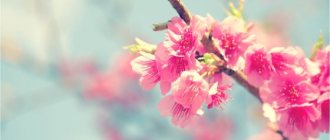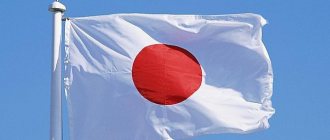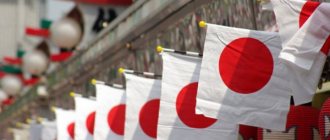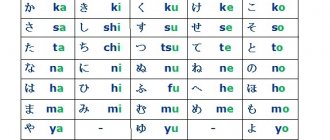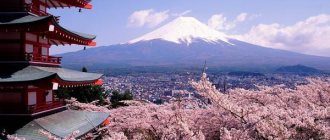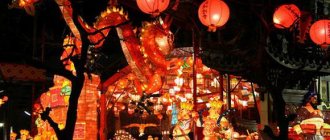Japanese cherry
When TV programs talk about this country, they always show a video or photo of cherry blossoms. Delicate white and pink flowers attract attention, exude a light aroma and are a delightful sight. If you've never seen Japanese cherry blossoms, it's definitely worth a look! It's just a fairy tale. In many parks, along roads, near some offices or cafes in Japan, entire alleys of magnificent trees are planted.
What does sakura symbolize?
The sakura branch represents various interesting moments, I’ll tell you more about this.
- Human life.
Sakura blooms for a certain period, from March to April (depending on the area), it does not last long, thereby showing how fleeting, but at the same time beautiful our life is. Everything in it is natural: birth, life, withering and death.
- Prosperity. During cherry blossoms, religious holidays also take place, part of which includes prayers asking for a good harvest.
- Purity and beauty. The Japanese associate cherry blossom petals with their women. They are also pure and beautiful. There is even a Japanese name for girls - “Sakura”, the personification of these qualities.
- Waiting for something new. It is said that the appearance of pink flowers coincides with the time when Japan used to celebrate the New Year. We all know that every year is marked by the expectation of magic, new achievements and positive changes.
Sakura flowers are used in everyday life. Images of amazing flowers adorn clothing, household items, writing paper and other things surrounding the Japanese.
Bloom Day
The main spring event is “hanami” (花見・“hana” is a flower, and “mi” is to look, admire). This is an ancient Japanese tradition of celebrating cherry blossom days; it has existed for centuries. Although it is not officially celebrated, and there are no specific days off for this, it is infinitely important for all Japanese. People gather in families and couples in squares and parks where cherries grow.
They take bento (packed lunch boxes) with them and eat in nature, admiring the luxurious view. Often during such holidays, girls and children wear yukata (national costume), music plays, and there are tents selling various goodies.
It can be fried hot noodles with meat and vegetables in sauce (“yaki soba”), corn cooked on the grill (I probably love it the most), donut-like pastries (“baby castela”) and many other tasty things.
There is a mobile shooting range for children, catching goldfish with a special paper net (a popular Japanese pastime - goldfish swim in a wide “basin”. You pay money, they give you a net, how many fish you catch before the net breaks, you can take home so many, i.e. e. take it to your aquarium). Sometimes it happens that not one is caught, but there are also professionals :-).
Chrysanthemum. Flower symbol of Japan
Nowadays, anime from Japanese creators is at the peak of popularity among children, young people, and even many adults. Perhaps this is why many fans of Japanese animation want to learn more about the Land of the Rising Sun. In fact, the rich history, culture and identity of Japan can not only delight, but also surprise and amaze.
What flower is the symbol of Japan?
Many people are sure that the flower symbol of Japan is sakura. However, this is a big misconception. Residents of the country love the chrysanthemum so fiercely that they have unofficially recognized it as the symbol of Japan. The official name of this plant is “kikkamonsho”, i.e. "coat of arms in the form of a chrysanthemum." Moreover, it is the flower with 16 petals that is considered a sign of imperial power, the Sun and wealth. It is often mistaken for the state emblem. The chrysanthemum flower adorns the coat of arms of the Japanese imperial court, and it is also located in Japanese passports.
Chrysanthemum as a symbol of Japan. Legend
Even Japan itself should thank the chrysanthemum for its origin. In ancient times, according to a famous legend, the cruel Chinese emperor learned that a magical plant, the chrysanthemum, grew on the islands overseas. An elixir of immortality could be prepared from the juice of this flower. However, the magic had power if the flower was picked by an honest, kind person with good intentions. The Emperor knew that neither he nor his subordinates would be able to maintain this power, since they all had evil hearts. Therefore, he found an honest doctor and selected three hundred girls and boys so that each one would pick a flower. Of this number, there must surely be at least one person who is able to maintain this action. On the island, all the people were fascinated by the beauty of the area. They all understood that after they returned, the emperor would execute them, so no one dared to come back to their homeland. On the island they founded their own state called Japan.
A few facts about chrysanthemum
Chrysanthemum is considered one of the most common types of flower crops on our continent. Chrysanthemum received universal recognition and love for its diversity of types and forms. Certain types of flowers came to us from the Mediterranean and African countries, but China and Japan are still the main homeland. The first image of a flower is considered to be a drawing on Chinese porcelain found by archaeologists. These products were made at least 2.5 thousand years ago. The flower can be seen in patterns on fabrics, dishes and vases. In ancient times, the chrysanthemum depicted on clothing was considered sacred, and therefore it was worn only by representatives of the imperial family.
The flower symbol of Japan represents happiness and wisdom, because... The ancient Japanese identified this bright plant, radiating power and energy, with the Sun. It is the chrysanthemum that is associated with the Sun Goddess - Amaterasu, who is considered the head of the divine temple and the ancient ancestor of the Japanese emperors.
The symbol flower chrysanthemum in Japanese life
Back in the 12th century, Emperor Gotoba, during his reign 1183-1198, was an ardent admirer of the chrysanthemum, and used the symbol of Japan as his personal seal. Following him, this tradition was supported by the rest of the rulers of the Kamakura era. Subsequently, it so happened that the tacit consent of the ruling clan elevated the chrysanthemum to the status of a sacred insignia of imperial persons.
Officially, the chrysanthemum with 16 petals was used as the coat of arms of the imperial court in 1869. Just 2 years later, the government issued a decree, according to which the right of representatives of the imperial house to use the image of a chrysanthemum was secured. However, all other Japanese did not have the right to use it. Currently, this ban is no longer valid.
During the Second World War, the chrysanthemum became a symbol of the Great Japanese Empire. The image of the chrysanthemum was attached to military aircraft and ships. Kamikaze warriors were also allowed to use the flower, the symbol of Japan, as a sign of courage. Soldiers' helmets, sleeve patches and covers were decorated with an anchor and a chrysanthemum. The names of military operations also mentioned the name of chrysanthemum.
Healing and magical properties of chrysanthemum
Ancient Japanese women wiped their face every day with a piece of cloth that was soaked in the dew of chrysanthemum flowers. It was a kind of ancient facial tonic. In the old days, beautiful girls were called “o-kiku-san” (おきくさん), thereby comparing their cuteness to a chrysanthemum.
The Japanese have long believed that the symbolic flower of Japan, which was picked on the 9th day of the 9th month, has magical powers. They sincerely believe that these plants can protect against diseases and all kinds of misfortunes. It was on this day that all of Japan. Nowadays it is not a public holiday, but in the Heian era it was celebrated on a grand scale by noble Japanese. The imperial court received many guests, among whom there were always poets and musicians. There were competitions for the best poem about the chrysanthemum, boat rides decorated with these flowers, and general admiration for the floral arrangements.
It turns out that the symbol flower of Japan and its leaves can be eaten. They have been used to strengthen and maintain health for several centuries, and not only in Japan. The substances contained in chrysanthemum help to stock up on vitality and preserve them for a long time.
To prepare various dishes, young flowers and leaves of vegetable chrysanthemum are taken, containing the maximum amount of useful substances. A small amount of this drug is enough to improve the health of the entire body. Vegetable chrysanthemum leaves that are suitable for consumption are called shungiku. They have a pleasant smell and an unusual spicy taste that can elevate any ordinary dish. The leaves are used to prepare salads and seasonings for meat and fish dishes, as well as omelets, mashed potatoes and sandwiches. The leaves can be dried and used in ground form. I wonder if you would dare try a similar dish and would you like it?
The Japanese firmly believe that chrysanthemum petals in a glass of wine will ensure good health and long life. The symbol of Japan is reverently protected, new varieties are bred and carefully studied by gardeners.
A few more interesting facts about the symbol of Japan - the chrysanthemum
Translated from Japanese, the name of the chrysanthemum means “Sun,” so it symbolizes this celestial body that gives life to everything on the planet. Residents of the Land of the Rising Sun deeply respect the symbol flower of Japan and devote a lot of time to its growth and breeding new varieties.
The love for chrysanthemum in the East is limitless, which is why national holidays are dedicated to it. It is rightfully considered a symbol of prosperity, longevity and happiness. A bouquet of chrysanthemums is considered an excellent way to show friendly feelings, since the chrysanthemum brings fun, joy and relaxation, and also helps to show the openness of friendships. At the same time, a red flower signifies the manifestation of passionate love feelings, a yellow color speaks of tender love, and a white flower signifies sincerity.
Today, the symbol of Japan exists primarily for aesthetic pleasure. Since the 17th century, Nihonmatsu has been considered an important and large center of Japanese floriculture. It is here that exhibitions are held annually in the autumn. Throughout the province you can see buildings, statues and chrysanthemum beds. Of great interest to the public are dolls that represent a frame with a head, and the clothes are made up of chrysanthemums, carefully selected by designers.
Owners decorate their cars with chrysanthemums. Flowers and arrangements, where the symbol of Japan plays the main role, can be provided by anyone, from schoolchildren to entire offices of large companies. That’s why in Japan they grow absolutely everything from small to large chrysanthemums.
Chrysanthemum is considered a universal flower, almost the most ancient on our planet. The rich history of the plant’s existence goes back to ancient times. Many references to the flower are found in the manuscripts of philosophers who admired and enjoyed the beauty and properties of the beautiful plant. Thanks to them, the popularity of chrysanthemum quickly spread from the East to Europe back in the Middle Ages.
What do you know about the chrysanthemum - the symbol of Japan? Share in the comment.
There are very few places left in our main course “Japanese for Beginners in Three Steps“. Hurry up to sign up for it using the link!
We recommend:
Chrysanthemum - a symbol of the Empire
Now this bright flower, imported from China, is revered in Japan as a symbol of the Sun. There is a belief that in ancient times one of the Japanese emperors, who was partial to the chrysanthemum, made its image with his seal. So, over time, the flower turned into the coat of arms of the imperial family. And subsequently, it grew into a symbol of the entire Japanese Empire.
Now the flower and the sun merge into one whole in the minds of the people of Japan, the words even have the same sound and hieroglyph. And the highest award in this country, as you probably already guessed, is the Order of the Chrysanthemum. Japanese coins also did not stand aside, for example, on 50 yen, there is an image of this sunny flower.
What is the main flower for the Japanese?
Chrysanthemum is the national flower. Symbol of Japan, imperial power, honor, courage, nobility, happiness and wisdom. This plant is inextricably linked with the sun, from which, according to legend, the Japanese people trace their history.
Japanese legends say These flowers are not only loved, they are adored by everyone - from young to old, from the emperor to the last poor man. Back in the Heian era, when chrysanthemums bloomed, ordinary people decorated their homes with them, and the nobility rode on “chrysanthemum” boats. Poems were written about these flowers, songs were sung, and poetry competitions were held in their honor. According to one of the ancient legends, Japan owes its origin to the chrysanthemum. In ancient times, China was ruled by a cruel emperor. One day he heard a rumor that across the sea, on an island, a magical flower was growing - a chrysanthemum. An elixir of longevity can be prepared from the juice of this flower. But only a person with a pure heart and good intentions can pick a flower. The emperor and his courtiers had unkind hearts, and the emperor decided to use a trick: send three hundred young boys and girls to the island. But none of them returned to the emperor: enchanted by the beauty of the island, they founded a new state - Japan. 2. A specially protected flower Since the 7th century, the chrysanthemum has been considered a royal flower and became the emblem of Japanese emperors. The golden flower with sixteen double petals remains the coat of arms of the Imperial House today, and sometimes serves as the state emblem: its image can be found on coins, seals and official documents. Japan's highest honor, the Order of the Chrysanthemum, is awarded only to persons of imperial and royal blood, heroes and heads of foreign states. This order is made of gold and has 2 degrees: on a chain and on a Great Ribbon. Chrysanthemum in Japan is surrounded by love and care. The Japanese have no equal in the industrial cultivation of these flowers and in the creation of new varieties. In total, there are about five thousand species of this plant in Japan. These flowers have a long flowering period. Because of this, in Japanese culture, the chrysanthemum represents happiness and longevity, and dew collected from the chrysanthemum is said to prolong life. For several centuries, simple amateurs and professional gardeners
Chrysanthemum time On September 9, all of Japan celebrates the Chrysanthemum Festival. The history of this holiday began in 1186. Originally these were celebrations associated with longevity. Since the chrysanthemum is a symbol of longevity, the holiday will later receive a second name - the Chrysanthemum Festival. And during the Tokugawa era, it became one of the public holidays. In ancient times, this holiday was celebrated only at court, where, at the invitation of the emperor, the court nobility, poets, and musicians gathered. Everyone had to compose a poem in honor of the celebration. During the Chrysanthemum Festival, flower beds with chrysanthemums bloom throughout the country, flower exhibitions are held, and doll festivals are held. Dolls, both individual characters and entire paintings on historical, religious or mythological subjects, are created from living plants, for which a special frame is prepared from bamboo, and the face, arms and legs are made from wax or papier-mâché, very carefully and naturally. The costumes and the background on which the action takes place (waterfalls, mountains, buildings) are created from the leaves and flowers of various varieties of chrysanthemums. By selecting different shapes and shades of chrysanthemums, they make purple capes for the courtiers - from purple petals, green hakama pants - from leaves, yellow hats - from yellow varieties. These plants are watered morning and evening, thanks to which they remain alive for a whole month. If individual plants become sick or wither prematurely, they are carefully replaced with new ones, and the dolls and landscapes remain almost unchanged. Well, maybe the hero’s pose or the lighting of the grove changes a little. The Japanese Chrysanthemum Festival is an event no less spectacular than the carnival in Venice.
What does it symbolize
But at the same time, unlike sakura, chrysanthemum has a slightly different meaning. It is considered a more formal flower, often used in ritual services. For example, relatives and friends, visiting the graves of dear people, bring chrysanthemum flowers with them.
Chrysanthemum is a multifaceted flower symbolizing “nobility”, “purity”, “faith”, “love”.
If we consider what the colors of chrysanthemums mean, we get the following:
- Red - love
- Yellow - virtue, emerging feelings - a little love
- White - honesty, truth
- Dark - calls for trust, thereby saying that the giver can open up
As a rule, these flowers are not given to young people, but sometimes chrysanthemum is included in some bouquets.
Chrysanthemum Festival
In the ninth lunar month, just on the day of the autumn equinox, the Chrysanthemum Festival is celebrated. Special services are held in Buddhist temples, cars decorated with chrysanthemums drive through the cities, and cafes offer dishes with the addition of petals from the “second sun of Japan.” When the chrysanthemum flowering comes to an end and autumn approaches, an unusual exhibition is held in Japan. Living chrysanthemums are used to create images of people. The result is unique dolls whose figures are formed from bright colors.
Who would have thought, but the Japanese eat yellow flowers. They developed a special vegetable variety. The leaves of this chrysanthemum are similar to carrots, and the flowers are a little reminiscent of chamomile. They eat only young leaves and flowers. They have a pleasant smell and unusual taste. Chrysanthemum is added to salads, meat and fish, and sometimes to desserts. True, in very small quantities. It is believed that eating this plant is beneficial; it helps in strengthening physical and mental health. But in any case, there will definitely be no harm from this!
We can talk endlessly about Japan, its uniqueness and traditions. Today we have only touched on the characteristics of this country. I promise we'll talk about her again. Thank you for taking a little journey with me today and learning about Japanese flower symbolism! If you subscribe to blog updates, you will learn more. I would be glad if you recommend my page to your friends from social networks. Have a magical day! And all the best!
Lika Raido
LiveInternetLiveInternet
In the minds of the Japanese, chrysanthemum and the Sun are inseparable. Even the words denoting these concepts sound the same - “kiku” and are depicted with the same hieroglyph. So the main flower of Japan is named after the luminary, from whom, according to legend, the Japanese people trace their history.
A very honorable place is given to the chrysanthemum in state symbols. Presumably since the 7th century, when a design of a chrysanthemum adorned the blade of the Mikado, it has been considered the emblem of Japanese emperors. A stylized golden flower with sixteen double petals still remains the coat of arms of the Imperial House, and sometimes serves as the state emblem: on coins, seals and official documents. It was this image of the chrysanthemum that was considered sacred; the right to it, in particular, to wear clothes with a pattern of a 16-petal flower, belonged exclusively to members of the imperial family. Ordinary Japanese who violated this order faced the death penalty. The same chrysanthemum adorns the Order of the Chrysanthemum, established in 1888 and to this day considered the highest and most honorable award in the country. However, for the Japanese, a solar flower is not just a symbol frozen in metal. This plant in Japan is surrounded by love and care. The Japanese have no equal in the industrial cultivation of chrysanthemums, in the creation of new varieties with a variety of shapes and colors. Apparently, due to its long flowering period, the chrysanthemum represents happiness and longevity. There is a belief that dew collected from chrysanthemums prolongs life.
The highest Japanese order is the Order of the Chrysanthemum. This order exists in two degrees: the Order of the Chrysanthemum with a chain and the Order of the Chrysanthemum on the Grand Ribbon.
The highest Japanese award,
the Order of the Chrysanthemum with Chain
, was established by Imperial Edict No. 1 of January 4, 1888, which states that it is “awarded to those who are already holders of the Order of the Chrysanthemum on the Grand Ribbon.” Only princes of the imperial family, the highest aristocracy, national heroes and heads of foreign states can be awarded the Order of the Chrysanthemum with a Chain.
The actual chain of the Supreme Order of the Chrysanthemum has 12 links made of gold. These links are interspersed with gold chains by thirty medallions with gold chrysanthemums surrounded by leaves covered with green enamel. The badge of the Order of the Chrysanthemum with a chain with a diameter of 60 mm is made of gold. In its center there is a strongly convex sphere (cabochon) made of Japanese red enamel, reminiscent of a ruby in appearance. It is surrounded by 32 white enamel double arms of varying lengths that form a cross. The cross is framed by leaves made in green enamel and four symmetrically arranged chrysanthemum flowers covered with yellow enamel. The badge of the order is attached to the chain using a large pendant in the shape of a chrysanthemum, covered with yellow enamel. The order badge and chain contain 300 grams of 950-carat gold. The Order of the Chrysanthemum on the Grand Ribbon
is intended to reward Japanese and foreigners from among the members of the imperial and royal families and the highest aristocracy, as well as heads of foreign states.
The Grand Cordon badge of the Order of the Chrysanthemum has the same appearance as the Order of the Chrysanthemum badge with chain. Apart from members of the Imperial House, only 13 Japanese nationals have received this highest honor. Their list is currently “closed” by former prime ministers Yoshida Shigeru and Sato Eisaku, who were awarded posthumously in 1967 and 1975, respectively. The Order of the Chrysanthemum with Chain was awarded to US President D. Eisenhower (1960), Queen Elizabeth of Great Britain (1962), and senior leaders of Malaysia, Afghanistan, and Saudi Arabia.
The chrysanthemum was depicted on coins
Late autumn
No flower compares
With white chrysanthemum.
Give her your place,
Stay away from it, morning frost! Saigyo
Chrysanthemum - Japan's favorite
, it has been cultivated here since time immemorial.
This is a national flower, the entire population is fond of it, from the Mikado to the last rickshaw puller. Her image is sacred, and according to state laws, only members of the imperial house have the right to wear material with her design. The rest, in case of violation of this law, are punishable by death.
Any attempt to depict this emblem of the Japanese empire and symbol of imperial power is punishable by death, and therefore the Japanese government sometimes even resorts to depicting it to prevent the counterfeiting of government banknotes.
Thus, several years ago, the director of the government printing house of state postage stamps resorted to the image of a chrysanthemum in order to prevent the fabrication of ancient postage stamps, which were purchased willingly and for a lot of money by foreign collectors. But cunning forgers bypassed him. As you know, only the symbolic chrysanthemum (golden flower) with 16 petals enjoys the power of government protection.
Japanese artists, very cunning and dexterous in imitation, perfectly reproduced a whole series of “antique” postage stamps, but
depicted a flower with only 14 and 15 petals.
If a flower had 16 petals, counterfeiters would be in danger of being subjected to hara-kiri, and no one has the right to persecute them for chrysanthemums with fewer or more petals, and they calmly continue to sell their counterfeit brands to inexperienced lovers for good money.
Itsukushima Sacred Gate
There are two types of regular passports, with different validity periods: five and ten years. Citizens under 19 years of age can only obtain a five-year passport, while those 20 years or older can choose which passport to use: a five-year (blue cover) or a ten-year (red cover) for a different application fee.
As for the fake of the real state emblem of the chrysanthemum with 16 petals, the Japanese, strictly observing and respecting all the laws of their country, never even tried to reproduce it;
at least until recently there was not even such an attempt. The image of this flower is placed on the national flag, on coins and on the highest Japanese order, which even bears the name of the Order of the Chrysanthemum.
The reason for such high veneration of this flower by the Japanese is best explained by its very name: “kiku” (sun). He is their symbol of this luminary, which gives life to everything on earth. The chrysanthemum began to be used as such a symbol of power in Japan, apparently a very long time ago, back in the 12th century, evidence of which is the first image of it on the saber blade of the Mikado who reigned at that time. One of the most beloved national folk holidays in Japan is associated with this flower - the Chrysanthemum Festival. To explain such a celebration, it must first of all be said that, as is known, in Japan and China there are no Sundays, and therefore weekdays, working days, would have to follow continuously in tedious monotony all year round, if the people had not created holidays for themselves that would break this monotony and bring some fun into life.
And among these kinds of celebrations, the first place among the Japanese is occupied by flower festivals.
In February, holidays are held on the occasion of the flowering of plums
, in March - peaches, in April - cherries, in May - known in our country as wisteria, in June - bindweed and peonies, in October - chrysanthemums, and in the fall people also give up work and runs to admire the reddening and yellowing foliage of Japanese maples.
The spring holiday - cherry blossoms and the autumn holiday - chrysanthemum blossoms
are distinguished by the greatest luxury and charm This wonderful tradition is still alive: since 831, it has been customary in Japan to celebrate the Chrysanthemum Festival. One of the most beautiful and beloved by the Japanese, this holiday is held annually in the fall. To this day, festivals and exhibitions of these sunny flowers and compositions from them are held in the capital and other Japanese cities, to create which plants are taken only from the roots in order to preserve their freshness and beauty for as long as possible. And in one of the largest centers of Japanese floriculture, the city of Nihonmatsu, in the fall there is an exhibition of chrysanthemum dolls. The base of the human-sized figures is made of bamboo, the face, arms and legs are made of papier-mâché, and the costumes are “sewn” from flowers of various shades. During the holiday, as in ancient times, you can try a chrysanthemum drink. They say it is healing and pleasant to the taste.
exhibition of ningyo dolls made from living chrysanthemums
Chrysanthemumnot just loved - she is worshiped from young to old, from the emperor to the last beggar
. Since ancient times, when chrysanthemums bloomed, ordinary people decorated their houses with them, and the nobility rode on “chrysanthemum” boats. They wrote poems about chrysanthemums, sang songs, and organized poetry competitions for their sake.
These poems were and are written in ink on long strips of paper and glued to trees.
; so that not only people read them, but even the wind, as it were, spreads the news about them around the world.
Quiet morning, a monk is sipping tea - Chrysanthemum flowers. A hermit drinks tea on a quiet morning, looking at the chrysanthemums. Basho (Translation by Dmitry Smirnov)
The history of this chrysanthemum festival began when kugatsu-sekku, the festival of the ninth moon, was first celebrated at the emperor’s court, and they began to celebrate it on the 9th of the 9th month according to the lunar calendar and changed the name to Choyo-sekku - the choice of date was not accidental: nine in the eastern tradition it is considered a lucky number, and two nines in a row (hidden in the name of the holiday) mean “longevity.”
Since the chrysanthemum is a symbol of longevity, the holiday will later receive a second name - the Chrysanthemum Festival. During the Tokugawa era, it became one of the public holidays of Gosekku.
A popular motif in irezumi is an indicator of courage, fearlessness, greatness and nobility. The chrysanthemum was also a symbol of Japanese suicide pilots (kamikaze) going on missions
Chrysanthemum has long been used in Japanese cooking - salads, tinctures, wine.
Nowadays, the Japanese create amazingly beautiful wagashi sweets. For seasonal holidays, they prepare something completely special: for example, in September you can see wagashi in the shape of a kiku flower, chrysanthemum, moon, rabbit, and maple leaves.
Chrysanthemum flowers and leaves are wonderful food.
They have been used as food to improve health for several centuries and not only in Japan.
It is known that chrysanthemum nourishes not only the body, but also the soul. These flowers resist the breath of autumn and the gray hairs of winter; they help a person survive harsh times, store and retain vitality. Young leaves and flowers of the annual vegetable chrysanthemum, which contain many useful substances, are used as food. Young leaves are especially useful in early spring or late autumn. They eat chrysanthemum flowers and leaves little by little: this is quite enough to improve health. And the moth arrived!
He also drinks an incense infusion of chrysanthemum petals. Matsuo Basho The edible leaves of the vegetable chrysanthemum are called shungiku in Japan. They have an interesting pleasant smell and a spicy taste that decorates any dish (they are boiled for several minutes, squeezed out, finely chopped and served with seasoning). From fresh vegetable chrysanthemum leaves pre-boiled in salted water, you can prepare a delicious salad, seasoning for meat or fish, mashed potatoes and sandwiches. They add a piquant taste to omelettes and egg dishes. They can be dried, ground and used in dried form as a healthy and pleasant seasoning for food.
The soul rests and heals only by admiring flowers
. Chrysanthemums are a symbol of joy and laughter. It is believed that chrysanthemums bring happiness, success, luck, and have the ability to ward off illness and misfortune. According to ancient tradition, a chrysanthemum petal is still placed at the bottom of a sake bowl to live a long and healthy life. The Japanese believe that dew collected from chrysanthemums prolongs life. Japanese beauties wiped their faces with a cloth soaked in chrysanthemum dew to preserve youth and beauty. Matsuo Basho The old woman is destroying the rice And next to it is a sign of longevity - Chrysanthemums in bloom.
The name “chrysanthemum” comes from two Greek words: chrysos - “golden” and anthemis - “flower”, which is explained by the natural yellow color of chrysanthemum inflorescences, reminiscent of a crown of small jagged petals. There were special beliefs and rituals associated with chrysanthemums. Wishing someone health and longevity, they presented sake with chrysanthemum petals.
They also made an infusion of flowers, leaves and stems of chrysanthemums, which they kept for a whole year and drank only on the next holiday.
The beauties wiped their faces with a cloth soaked in the dew of chrysanthemums in order to preserve youth and beauty. In the Heian era, chrysanthemum flowers were used to “prevent misfortunes
” - they were wrapped in cotton cloth so that it was saturated with aroma and then the body was wiped with this cloth for the sake of health and longevity. Today, the Japanese call the most beautiful girls O-Kiku-san, comparing them with kiku chrysanthemum and with the sun.
bonsai
Japan even owes its origin to the chrysanthemum. In ancient times, the legend says, a cruel emperor ruled in China. One day he heard a rumor that across the sea, on an island, a magical flower was growing - a chrysanthemum. An elixir of longevity can be prepared from the juice of this flower. But only a person with a pure heart and good intentions can pick a flower. The emperor and his courtiers had black and evil hearts, and the emperor sent three hundred young boys and girls to the island in his place. But none of them returned to the emperor: enchanted by the beauty of the island, they founded a new state - Japan...
Coat of arms and flag of Japan
The Imperial Seal of Japan (Japanese: 菊の御紋kiku no gomon?) is a symbol in the form of a yellow or orange 16-petal chrysanthemum. Since the Kamakura period, it has been considered the emblem of Japanese emperors and members of the Japanese imperial family. The imperial seal is sometimes used as a national emblem, although there is no official national emblem in Japan. The image of the imperial seal consists of a central circle surrounded by sixteen petals, with a second row of petals surrounding them outside.
The chrysanthemum was first used as a personal seal by Emperor Go-Toba. The image of the chrysanthemum has been adopted as the mona of the imperial house since 1869. During the Meiji Restoration, according to the 1871 decree, no one was allowed to use this seal except the Emperor of Japan. After World War II, this ban was lifted. Each member of the imperial family had their own modified version of the imperial seal with 14 petals. Shinto shrines also use the imperial seal, or part of it in a modified form. Currently, the symbolic image of the chrysanthemum is used in the premises of the Japanese Parliament and diplomatic institutions, on the attributes of politicians, and is also placed on the covers of Japanese foreign passports.
The flag of Japan (Japanese: 日章旗Nisshoki?, sun flag) is a white canvas with a large red circle in the middle, representing the rising sun. According to legend, the tradition of this flag dates back to the 13th century, from the time of the Mongol invasion of Japan. The flag was offered to the Japanese emperor, considered a descendant of the Sun Goddess, by Buddhist monks. The flag began to be considered as a state flag during the era of national restoration after 1868.
The flag has an aspect ratio of 2:3 and is the state and civil flag of Japan, as well as the state and civil pennant (badge). Officially in Japan the flag is called "Nisshoki" (Japanese: 日章旗), "solar flag", but the more common variant is "Hinomaru" (Japanese: 日の丸, alternative spelling "Hi-no-maru"), "sun disk". Hinomaru's exact origins are unknown. One legend attributes the creation of the flag to the Buddhist monk Nichiren. According to legend, during the Mongol invasion of the Japanese Islands, Nichiren presented the flag to the shogun.
Ikebana
About 350 species of wild chrysanthemum grow in Japan.
The most common types:
大菊(一輪菊) Ookiku, Ichirinku – large, curling chrysanthemum:
厚物 Atsushimono, 厚走り Atsushi-hashiri - rounded:
管物 Kanbutsu - needle-shaped:
Seen everything in the worldMy eyes are back
To you, white chrysanthemums. Issho
"Flower lover! You have become an inconspicuous Slave of chrysanthemums” - these words of Es Buson reflect the deep attraction that the calm charm of this flower gives rise to in the hearts of true connoisseurs of beauty.

